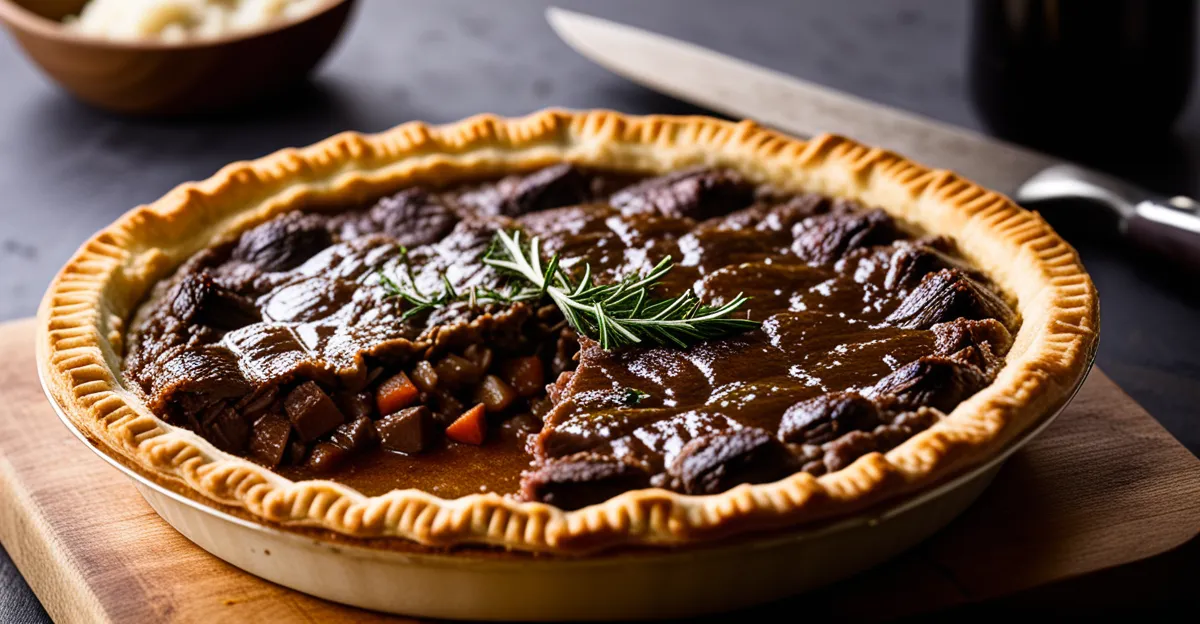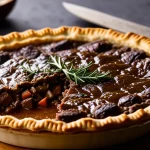Essential ingredients and equipment for steak and kidney pie
Choosing the right steak and kidney pie ingredients is crucial for authentic British pies. Traditionally, the filling relies on good quality beef steak and lamb or beef kidneys. For the steak, cuts like chuck or braising steak are favoured because they become tender with slow cooking. Kidneys must be fresh and well-cleaned to avoid any strong, off-putting flavours. Some cooks substitute pork or veal kidneys if preferred.
Key ingredients include onions, beef stock, and often a splash of Worcestershire sauce or ale to build complexity. Seasonings such as thyme, bay leaves, salt, and pepper enhance the traditional flavour profile.
Also to read : How can you make a traditional Bakewell tart at home?
Having the right essential cooking equipment makes preparation smoother. A heavy-based pan or Dutch oven is ideal for browning the meat evenly and slow simmering the filling. A sharp knife simplifies trimming and chopping both steak and kidneys precisely. For assembling, a sturdy pie dish and a rolling pin are necessary for handling the pastry. A sieve or fine colander also helps separate any impurities from the kidney after cleaning.
Focusing on these specific ingredients and tools lays the foundation for an excellent steak and kidney pie, capturing the essence of classic British pies.
Also to see : How can you create a delicious Welsh rarebit at home?
Preparing the meat and kidneys
Proper preparing steak and kidneys ensures the pie’s success by balancing flavour and texture. Start by selecting fresh, high-quality cuts of steak and kidneys. The steak should be trimmed of excess fat and sinew, while kidneys need thorough cleaning to remove any strong odours and impurities. Use a sharp knife to cut the steak into even chunks, around 1-inch pieces for even cooking.
For kidney cleaning tips, soak kidneys in cold water with a splash of vinegar or lemon juice for 30 minutes to neutralise strong flavours. After soaking, rinse thoroughly under cold running water. Remove any visible membranes and fat, then dice kidneys similarly to the steak. This step reduces the risk of off-putting tastes that some find unpleasant.
After preparation, pat the meat dry to encourage browning and prevent steaming during cooking. Proper meat preparation steps involve working efficiently but carefully; well-prepared ingredients contribute to a rich and balanced filling. This attention to detail in preparing steak and kidneys sets the foundation for a classic British pies experience admired for its hearty taste and texture.
Building the flavour base
Starting the pie filling preparation with sautéing onions and aromatics creates the essential depth in classic steak and kidney pie ingredients. Onions softened over moderate heat develop sweetness that balances the richness of the meat. Garlic, thyme, and bay leaves are commonly added at this stage to enhance the aromatic profile without overpowering.
Next, browning the meat is a critical step for developing flavour. Properly seared steak and kidneys develop a caramelised crust that intensifies the pie’s taste. Avoid overcrowding the pan, as this can cause steaming instead of browning, diminishing flavour.
Once the meat and aromatics are prepared, add beef stock and traditional seasonings like Worcestershire sauce and black pepper. These elements create a robust, savory base for the filling. Simmering with these seasonings allows the flavours to meld, producing the hearty essence typical of traditional seasonings in British pies.
This deliberate layering of flavours ensures that every bite delivers the balanced, rich taste expected from an expertly crafted steak and kidney pie.
Simmering the filling
Achieving the perfect pie filling texture depends on careful stewing the filling over the right amount of time. After browning, transfer the meat and aromatics to a heavy-based pan or Dutch oven. Add beef stock and seasonings, then bring to a gentle simmer. Maintaining a low heat is critical; a vigorous boil toughens the meat and reduces sauce quality.
For tender meat and a thick, rich sauce, cooking times typically range from 1.5 to 2 hours. This slow simmer ensures the steak and kidneys break down gently, melding flavours while softening connective tissues. Stir occasionally to prevent sticking, but avoid frequent stirring that can delay tenderising.
To achieve the correct sauce consistency, keep the pot partially covered to reduce liquid slowly. The sauce should coat the back of a spoon but not be too thin or watery. If the mixture remains too loose after cooking, a brief, uncovered simmer can concentrate the sauce further.
Before assembling your steak and kidney pie, allow the filling to cool completely. Cooling helps the filling set, preventing it from making the pastry soggy during baking and improving overall pie structure. This step is essential for the classic British pies experience.
Selecting and preparing the pastry
Choosing the right pie pastry options is vital for a classic steak and kidney pie finish. Traditionally, shortcrust pastry is preferred for its sturdy texture that holds the filling well without becoming soggy. It provides a crispy, buttery base that contrasts delightfully with the rich filling.
For those considering homemade versus store-bought pastry, homemade shortcrust allows full control over ingredients and freshness, often resulting in a flakier crust. However, well-selected store-bought pastry can save time without sacrificing too much quality. Whichever you choose, ensure pastry is cold before rolling to prevent shrinkage during baking.
When it comes to preparing pie crust, lightly flour your surface and rolling pin to avoid sticking. Roll the pastry evenly to about 3–5 mm thickness, large enough to line your pie dish and cover the top with some overlap for sealing. Gently lift the pastry to avoid tearing, then press it into the pie dish, trimming excess edges neatly.
A well-prepared pastry is essential; it must support the filling, maintain shape during baking, and deliver that satisfying crunch expected in traditional British pies.
Assembling and baking the pie
Careful pie assembly ensures your steak and kidney pie holds together perfectly while baking. Start by spooning the cooled filling evenly into the prepared pastry-lined dish, avoiding overfilling which can cause leaks. Next, roll out the top pastry and gently place it over the filling. Seal the edges firmly by pressing together or crimping to prevent steam escaping during baking.
Applying an egg wash—a beaten egg or egg yolk brushed over the top—adds a beautiful golden colour and glossy finish. For pastry decoration, simple slits or vent holes allow steam to escape and stop the pie from becoming soggy or bursting. You can also get creative by cutting shapes or patterns to enhance presentation.
Pie baking instructions usually suggest preheating the oven to around 200°C (400°F). Bake the pie for approximately 35 to 45 minutes until the pastry is crisp and golden brown. Avoid opening the oven door frequently to maintain consistent heat and ensure even baking.
Following these traditional pie techniques reliably produces a classic British pie with a crisp crust and perfectly cooked filling, delivering an authentic and satisfying meal.
Serving and storage tips
When serving steak and kidney pie, consider classic British accompaniments like mashed potatoes, steamed greens, or mushy peas to enhance the hearty flavours. These side dishes complement the rich, savoury filling perfectly, creating a balanced meal. Serving the pie warm is essential; it brings out the full depth of the steak and kidney pie ingredients and ensures the pastry retains its crispness.
For storage best practices, cool any leftover pie completely before refrigerating to prevent condensation from softening the pastry. Store the pie in an airtight container or cover loosely with foil. Proper refrigeration allows the pie to remain safe and tasty for up to three days.
When reheating leftovers, use an oven or toaster oven to maintain the pastry’s texture. Heat at 180°C (350°F) for 15-20 minutes until warmed through. Avoid microwaving, which tends to make pastry soggy and filling unevenly heated. For longer storage, steak and kidney pie freezes well; wrap tightly in plastic wrap and foil, freezing for up to two months. Thaw thoroughly in the refrigerator before reheating.
Following these simple tips ensures your steak and kidney pie remains delicious whether freshly served or enjoyed as leftovers.
Common mistakes and variations
A frequent steak and kidney pie tip is avoiding soggy pastry, which often results from assembling the pie with warm filling. Letting the filling cool fully before pie assembly prevents moisture from making the crust limp. Another common pie-making error is overcooking the kidney, which can cause a tough, rubbery texture. Optimal cooking involves careful stewing the filling at low heat to keep meat tender.
Variations exist to suit different tastes and dietary needs. Some cooks swap traditional beef kidneys for pork or veal, which offer milder flavours while keeping the essence of British pies. Others introduce ale or stout into the stock for extra depth. For gluten-free options, using alternative flours in the pastry addresses dietary restrictions without sacrificing texture.
Vegetarian adaptations replace kidneys with hearty mushrooms or root vegetables, maintaining a rich filling layered with traditional seasonings. These variations showcase the versatility of the classic recipe, encouraging experimentation while respecting core techniques. Recognising and correcting these common pitfalls enhances success and broadens appeal for this beloved dish.







